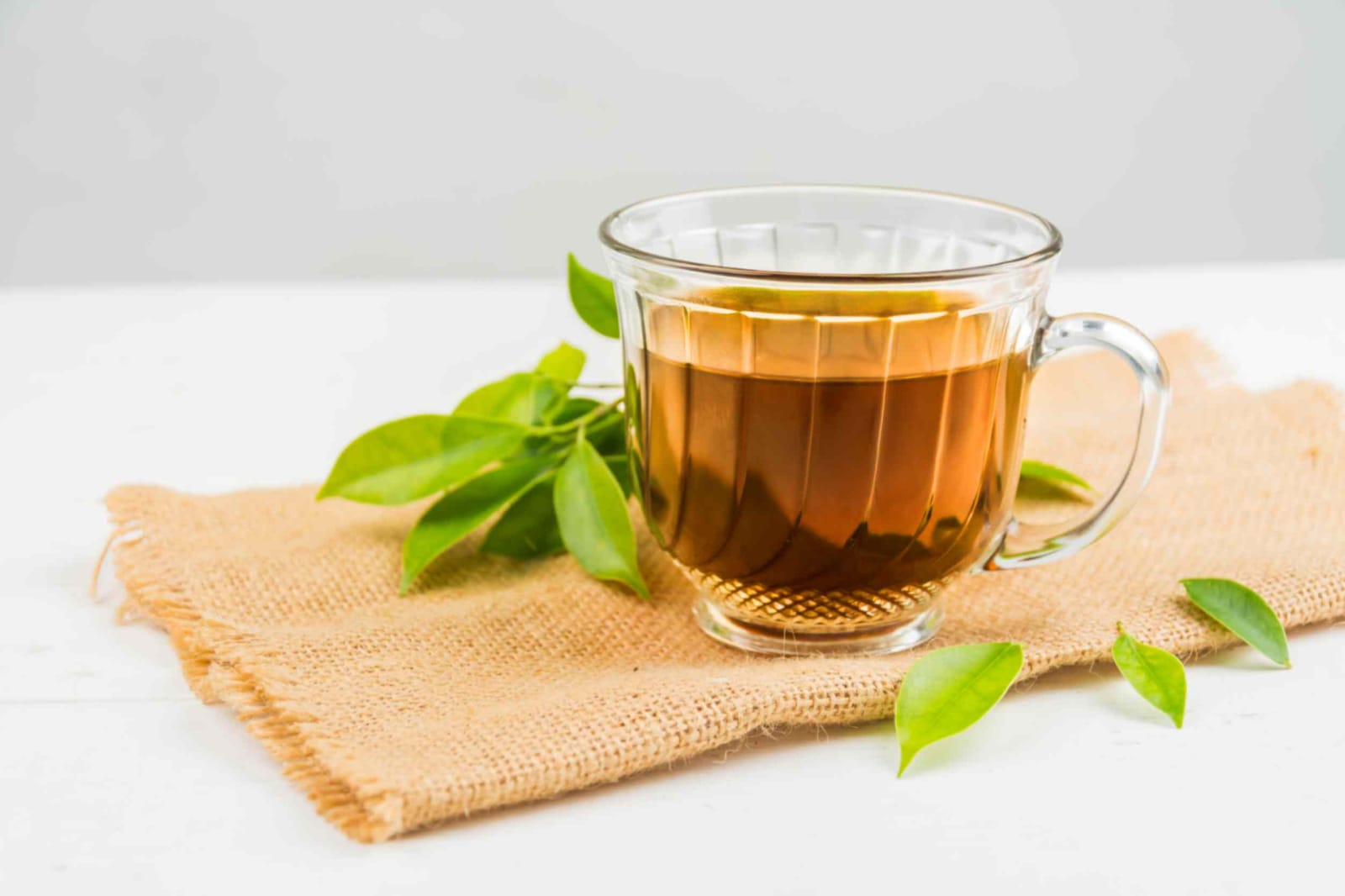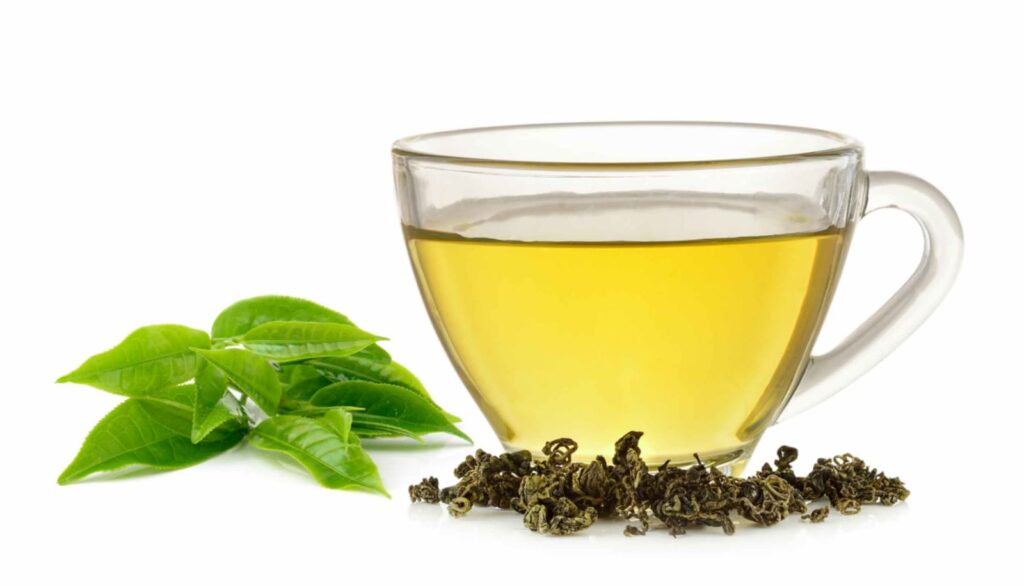Green tea is a type of tea that is made from the leaves of the Camellia sinensis plant, the same plant from which black tea and oolong tea are derived. What sets green tea apart from other types of tea is its minimal oxidation process during production. Here’s how green tea is made:
- Harvesting: Green tea leaves are typically harvested by hand or with specialized machinery. The timing of the harvest can affect the flavor and characteristics of the tea.
- Withering: After harvesting, the tea leaves are spread out to wither, allowing them to lose some of their moisture. This step is essential for the subsequent shaping and rolling of the leaves.
- Steaming or Pan-Firing: To prevent oxidation and preserve the green color, the withered tea leaves are quickly heated through either steaming (common in Japan) or pan-firing (common in China). This step stops the oxidation process by deactivating enzymes in the leaves.
- Rolling and Shaping: The tea leaves are rolled or shaped into various forms, depending on the type of green tea being produced. This step can impact the final flavor and appearance of the tea.
- Drying: The shaped tea leaves are dried to reduce their moisture content further, ensuring their long-term preservation and quality.
The result is green tea, which retains its green color, delicate flavor, and a range of potential health benefits due to the preservation of natural compounds like antioxidants and polyphenols. Green tea is known for its slightly astringent and often grassy or vegetal taste, though the flavor can vary significantly based on factors such as the tea’s origin, processing method, and brewing technique.
Green tea has been consumed for centuries and is associated with various cultural traditions, particularly in East Asia. It is celebrated not only for its taste but also for its potential health-promoting properties, which have made it a popular choice among those seeking a healthful beverage.

Is green tea good for weight loss?
Green tea has been studied for its potential role in weight loss and weight management, and while it is not a miracle solution, it can be a helpful part of a balanced diet and healthy lifestyle. Here are some ways in which green tea may contribute to weight loss:
- Metabolism Boost: Green tea contains compounds like catechins and caffeine that may help increase metabolism, which can lead to a slight increase in calorie burning.
- Fat Oxidation: The catechins in green tea may also promote the oxidation of fat, potentially helping the body utilize fat as an energy source.
- Appetite Control: Some studies suggest that green tea may help regulate appetite and reduce the feeling of hunger, which can lead to lower calorie intake.
- Improved Fat Absorption: Green tea may inhibit the absorption of dietary fat, which means fewer calories from fat are absorbed by the body.
- Stress Reduction: The L-theanine in green tea may have a calming effect, reducing stress-related overeating.
It’s important to note that the effects of green tea on weight loss are typically modest. To achieve significant weight loss, it is crucial to combine green tea consumption with a well-balanced diet and regular physical activity. Additionally, individual responses to green tea can vary, and not everyone will experience the same results.
Here are some tips for incorporating green tea into a weight loss plan:
- Consistency: For potential benefits, consider drinking green tea regularly, such as 2-3 cups per day.
- Avoid Excessive Sugar: Be mindful of adding sugar or high-calorie sweeteners to your tea, as this can counteract its weight loss benefits.
- Brewing Time and Temperature: Brew green tea properly by using hot, but not boiling, water and steeping for the recommended time (usually 2-3 minutes).
- Balanced Diet: Focus on maintaining a balanced diet that includes a variety of nutrient-rich foods.
- Physical Activity: Incorporate regular exercise into your routine, as it plays a critical role in weight management.
As with any dietary change, it’s a good idea to consult with a healthcare professional or a registered dietitian before making significant changes to your diet or lifestyle, especially if you have specific weight loss goals or underlying health conditions.

What are the health benefits of green tea?
Green tea has been consumed for centuries and is well-known for its potential health benefits. While individual responses may vary, here are some of the potential health benefits associated with green tea consumption:
- Antioxidant Properties: Green tea is rich in antioxidants, particularly catechins like epigallocatechin gallate (EGCG). These antioxidants help protect cells from damage caused by free radicals and oxidative stress, which may reduce the risk of chronic diseases, including cancer.
- Heart Health: Several studies suggest that regular consumption of green tea may help lower the risk of heart disease by improving cholesterol levels, reducing blood pressure, and promoting healthy blood vessel function.
- Weight Management: Green tea may assist in weight management and fat loss by boosting metabolism and increasing the oxidation of fat. It is often found in many weight loss supplements.
- Type 2 Diabetes: Some research suggests that green tea may improve insulin sensitivity and help regulate blood sugar levels, which can be beneficial for individuals with type 2 diabetes.
- Brain Health: The compounds in green tea, especially EGCG, have been linked to improved cognitive function and a reduced risk of neurodegenerative diseases like Alzheimer’s and Parkinson’s disease.
- Cancer Prevention: While the evidence is not conclusive, some studies suggest that the antioxidants in green tea may help reduce the risk of certain types of cancer, such as breast, prostate, and colorectal cancer.
- Dental Health: Green tea contains natural fluoride and compounds that can inhibit the growth of bacteria in the mouth, potentially reducing the risk of dental cavities and gum disease.
- Skin Health: The polyphenols in green tea may have a protective effect against UV radiation and promote skin health, potentially reducing the risk of skin damage and premature aging.
- Anti–Inflammatory Effects: Green tea may help reduce inflammation in the body, which is associated with various chronic diseases.
- Relaxation and Stress Reduction: Green tea contains an amino acid called L-theanine, which has a calming effect and can help reduce stress and anxiety while improving focus and alertness.
How to brew green tea?
- Choose Quality Tea:
- Start with high-quality green tea leaves or tea bags. Look for reputable brands and fresh products for the best flavor.
- Measure the Tea:
- For loose-leaf green tea, use about 1 teaspoon of tea leaves per 8 ounces (240 ml) of water. Adjust the amount based on your taste preferences.
- If using tea bags, one bag is typically sufficient for an 8-ounce cup.
- Select Fresh Water:
- Use fresh, filtered water for the best taste. Avoid using water that has been sitting for an extended period or has an unpleasant taste.
- Heat the Water:
- Heat the water to the appropriate temperature for green tea. Green tea is delicate and should not be brewed with boiling water, which can result in a bitter taste. The ideal temperature is usually around 175-185°F (80-85°C).
- If you don’t have a thermometer, you can achieve the right temperature by bringing the water to a boil and letting it cool for a few minutes.
- Preheat the Teapot or Teacup:
- Pour a small amount of hot water into the teapot or teacup to warm it. Swirl the water around and then discard it.
- Add the Tea:
- Place the green tea leaves or tea bag into the preheated teapot or teacup.
- Pour the Water:
- Pour the hot water over the tea leaves or tea bag. Ensure that the tea is fully submerged.
- Steep the Tea:
- Cover the teapot or teacup with a lid or saucer to trap the steam and aroma. Let the tea steep for the recommended time, which is typically 2-3 minutes for most green teas. Steeping time may vary based on the type of green tea, so refer to the packaging or your tea supplier’s recommendations.
- Strain or Remove the Tea Bag:
- If using loose-leaf tea, use a tea strainer to strain the tea into your cup, removing the leaves.
- If using tea bags, simply remove the bag from the cup.
- Enjoy:
- Green tea can be enjoyed plain or with optional additions like honey, lemon, or mint, depending on your taste preferences.
Is green tea safe during pregnancy?
Green tea contains caffeine, albeit in lower amounts than coffee, which raises questions about its safety during pregnancy. Moderate caffeine consumption during pregnancy is generally considered safe by many healthcare professionals, but it’s important to keep it within recommended limits. Excessive caffeine intake during pregnancy has been associated with an increased risk of preterm birth, low birth weight, and developmental issues. Therefore, if you’re pregnant or planning to become pregnant, it’s advisable to limit your green tea consumption and monitor your overall caffeine intake from all sources. Consulting with a healthcare provider is recommended to ensure your caffeine consumption aligns with your specific pregnancy and health circumstances. Additionally, some herbal teas, like peppermint or ginger tea, may be safer options if you’re looking for caffeine-free alternatives during pregnancy.
How much green tea should I drink daily?
The ideal daily consumption of green tea can vary from person to person, as it depends on factors such as individual tolerance to caffeine, health goals, and preferences. However, a general guideline is to aim for 2-3 cups of green tea per day to enjoy its potential health benefits without overdoing it. Each cup typically contains around 30-50 milligrams of caffeine, which is significantly less than a cup of coffee. If you’re sensitive to caffeine, you may want to start with a lower amount and gradually increase your intake. Keep in mind that excessive consumption of green tea, like any beverage with caffeine, can lead to potential side effects such as sleep disturbances or digestive discomfort. It’s always a good idea to listen to your body and adjust your intake accordingly. Consulting with a healthcare professional or registered dietitian can provide personalized guidance based on your specific health and dietary needs.
What are the side effects of drinking too much green tea?
Drinking excessive amounts of green tea can lead to several side effects. The caffeine content in green tea may cause insomnia, nervousness, and increased heart rate, affecting sleep quality and causing anxiety. Overconsumption can also upset the stomach, leading to digestive discomfort and nausea. High intake of green tea may interfere with iron absorption, potentially contributing to iron deficiency. Headaches, dizziness, and bone health concerns can arise, especially if it displaces calcium-rich beverages. There have been rare cases of liver and kidney damage associated with concentrated green tea extracts. Additionally, green tea can interact with certain medications, affecting their effectiveness. It’s crucial to moderate green tea intake to avoid these side effects and consult with a healthcare professional if you have specific health concerns or are on medications.
Does green tea contain caffeine?
Yes, green tea does contain caffeine, although the caffeine content is generally lower than that of coffee. The exact amount of caffeine in green tea can vary depending on factors such as the type of tea leaves used, the brewing time, and the temperature of the water. On average, an 8-ounce (240 ml) cup of green tea may contain anywhere from 20 to 45 milligrams of caffeine, whereas an 8-ounce cup of coffee typically contains around 95 milligrams or more of caffeine. The caffeine in green tea is often well-tolerated by most people and is known to provide a mild energy boost and alertness without the jittery side effects associated with higher doses of caffeine. However, individuals who are sensitive to caffeine or looking to reduce their caffeine intake should be mindful of their green tea consumption and consider opting for decaffeinated varieties.

Can green tea help with acne or skincare?
Green tea’s potential benefits extend to skincare, making it a popular ingredient in various beauty products and home remedies. It is rich in antioxidants, primarily epigallocatechin gallate (EGCG), which can help combat skin inflammation and damage caused by free radicals. These antioxidants may contribute to a healthier complexion by reducing redness, swelling, and signs of aging. Some studies suggest that topical application of green tea extracts or the use of skincare products containing green tea may help manage acne and promote clearer skin. However, it’s essential to note that while green tea can be a useful addition to a skincare routine, it’s not a standalone solution for severe acne or skin conditions. A holistic approach that includes proper cleansing, a balanced diet, and consultation with a dermatologist for specific skin concerns is recommended.
What is the difference between green tea and other types of tea?
The main difference between green tea and other types of tea, such as black tea and oolong tea, lies in their processing methods. Green tea undergoes minimal oxidation during production, which helps preserve its natural green color, delicate flavor, and potential health benefits. After harvesting, green tea leaves are quickly heated (usually by steaming or pan-firing) to prevent oxidation, which deactivates enzymes in the leaves. This minimal processing allows green tea to retain more of its original characteristics, including a lighter and fresher taste, as well as a higher concentration of antioxidants like catechins. In contrast, black tea is fully oxidized, resulting in a darker color, stronger flavor, and different chemical composition. Oolong tea falls between green and black tea in terms of oxidation levels, offering a range of flavors and characteristics based on the degree of oxidation. The diverse world of tea offers a variety of flavors and health benefits, making each type unique and appealing to different preferences.














